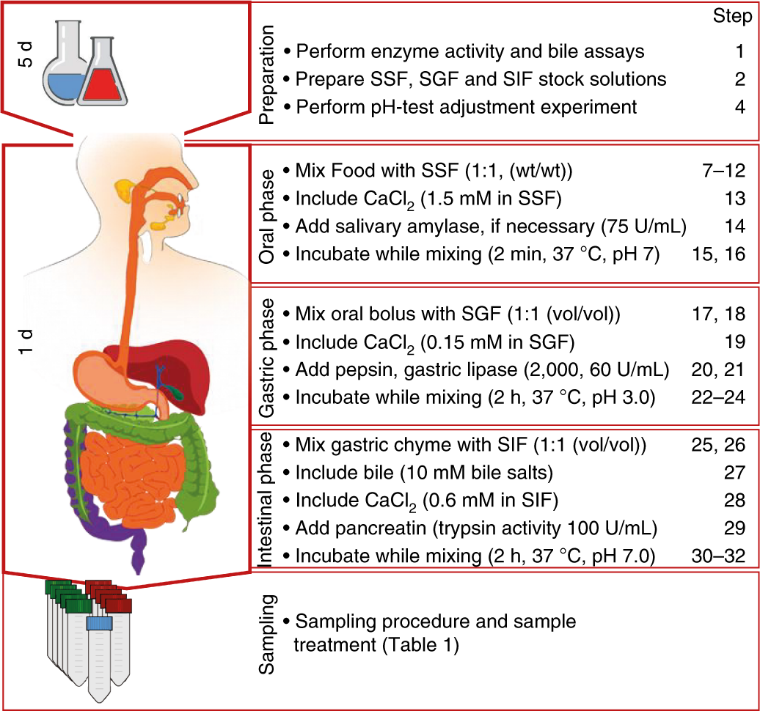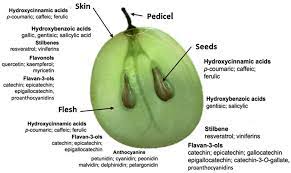
Hamid kheyrodin
Assistant professor. Semnan university-Iran.
*Corresponding authors: Hamid kheyrodin, Assistant professor. Semnan university-Iran.
Received Date: August 23, 2023
Accepted Date: October 19, 2023
Published Date: November 22, 2023
Citation: kheyrodin H, (2023). “Study of Composition of Grapes (Red and White Grape)”. Clinical Research and Clinical Case Reports, 4(2); DOI: 10.61148/ 2836-2667/JCRCCR/068.
Copyright: © 2023 Hamid kheyrodin. This is an open access article distributed under the Creative Commons Attribution License, which permits unrestricted use, distribution, and reproduction in any medium, provided the original work is properly cited.
Grapes offer health benefits, primarily due to their high nutrient and antioxidant content. They may benefit the eye, heart, bones, and more.. Grapes have been cultivated from times immemorial and are considered an important horticultural produce commercially. Red grape varieties provide more antioxidants than white or blush grape varieties. People use grape for poor circulation that can cause the legs to swell. It is also used for eye stress, heart disease, high cholesterol, high blood pressure, obesity, and many other conditions. Grapes are low in fat, cholesterol and sodium but high in ascorbic acid, retinol, phosphorus and caffeic acid, a strong cancer-fighting agent. Resveratrol, biologically active and well-characterized constituent of grape, which is present in abundance in the flesh of fruit is known for its various medicinal properties. It has high antioxidant activity. In addition, resveratrol is reported to strongly exhibit chemo-preventive and antineoplastic activity. Besides resveratrol, phytoalexin, oleanolic acid are present in abundance in grapes with reported positive health implications Too white grapes have a somewhat sour taste, while the red or blue varieties taste sweeter. In terms of nutritional value, minerals and vitamins, very few differences can be identified. All grape varieties consist mainly of water and have a relatively high fructose content.
Introduction:
Grapes are a good source of potassium, a mineral that helps balance fluids in your body. Potassium can help bring down high blood pressure and lower your risk of heart disease and stroke. Most people don't get enough of this nutrient, so eating grapes. Grapes are several nutrients important [2].
1. Packed with nutrients:
Grapes are high in several important nutrients. Just 1 cup (151 grams) of red or green grapes provides [1]:
2. May aid heart health:
Grapes may boost heart health in several ways. May help lower blood pressure
One cup (151 grams) of grapes contains 6% of the DV for potassium. This mineral is necessary for maintaining healthy blood pressure levels. Evidence shows that potassium helps lower blood pressure primarily by helping dilate your arteries and veins. It may also help excrete sodium and prevent the narrowing of arteries and veins that would otherwise increase blood pressure [5]. However, a review of 32 studies determined that potassium intakes that are both too low and too high may lead to high blood pressure. Researchers advised sticking to the current daily intake recommendation of 4.7 grams [3]. Compounds found in grapes may help protect against high cholesterol levels by decreasing cholesterol absorption . In an 8-week study in 69 people with high cholesterol, eating 3 cups (500 grams) of red grapes per day helped lower total and LDL (bad) cholesterol levels. However, white grapes didn’t have the same effect Additionally, diets high in resveratrol — an antioxidant in grapes — such as the Mediterranean diet have been shown to decrease cholesterol levels.

Figure 1: INFOGEST static in vitro simulation of gastrointestinal food digestion | Nature Protocols.
3. High in antioxidants:
Antioxidants are compounds that help repair the damage to your cells caused by free radicals — harmful molecules that cause oxidative stress. Oxidative stress is associated with several chronic health conditions, including diabetes, cancer, and heart disease [5].Grapes are rich in several powerful antioxidants. The highest concentration of antioxidants is found in the skin and seeds. However, multiple factors may affect their concentration, including grape variety, maturity, post-harvest storage, and environmental factors [8]. Interestingly enough, these beneficial compounds remain present even after fermentation, which is why wine is also an antioxidant source. Some grape varieties contain a higher content of anthocyanins, a class of flavonoids that give these fruits orange, red, blue, pink, and purple colors. Human and animal studies indicate that anthocyanins may help prevent or treat brain and heart diseases .Other important antioxidants in this fruit are resveratrol and quercetin, which may protect against heart disease, high blood sugar levels, and cancer [6]. Grapes also contain vitamin C, beta carotene, lutein, and ellagic acid, which are also powerful antioxidants.
4. May have anticancer effects:
Antioxidants in grapes may protect against certain types of cancer [8].Resveratrol, an antioxidant in this fruit, may help by reducing inflammation, acting as an antioxidant, and blocking the growth and spread of cancer cells in your body. Test-tube and animal studies show that grape extracts may block the growth and spread of human colon and breast cancer cells Additionally, a 2-week study in 30 people found that those over the age of 50 who ate 0.3–1 pound (150–450 grams) of grapes per day experienced decreased markers of colon cancer risk (25Trusted Source).
While more human studies are needed, a diet high in antioxidant-rich foods, such as grapes, has been linked to lower cancer risk .
5. May protect against diabetes and lower blood sugar levels:
Grapes contain 23 grams of sugar per cup (151 grams), which may make you wonder if they’re a good choice for people with diabetes. If you take a look at their glycemic index (GI) rating — a measure of how quickly a food raises your blood sugar — you’ll see that it ranges from 49–59, depending on grape variety .Similarly, the definition of low GI is variable depending on the source — some people consider under 55 as low, while others consider under 50 as low .This means that grapes’ GI score may range from low to medium, in which case they may raise your blood sugar levels at a slow or moderate pace but won’t necessarily spike it. However, keep in mind that eating too much of a low GI food will have the same effect on blood sugars as eating a high GI food. So, it’s best to eat grapes in moderation. In addition, compounds found in grapes may help improve markers of insulin response. In a review of 29 studies in 1,297 adults, grapes and grape supplements significantly decreased what’s called homeostatic model assessment of insulin resistance (HOMA-IR), a measure of insulin resistance .In particular, the compound resveratrol may improve your body’s ability to use insulin by decreasing insulin resistance.
Managing your blood sugar levels over time is important for reducing your diabetes risk and preventing diabetes-related complications. Though grapes are high in sugar, their low to moderate GI makes them fairly safe to eat in moderation if you have diabetes. Additionally, compounds in grapes may protect against high blood sugar.

Figure 2: Acute consumption of organic and conventional tropical grape juices (Vitis labrusca L.) increases antioxidants in plasma and erythrocytes, but not glucose and uric acid levels, in healthy individuals.
6. May benefit eye health:
Plant compounds in grapes may protect against common eye diseases.For instance, in a study in mice, those fed grapes showed fewer signs of damage to the retina and had better retina function than mice not given the fruit. Additionally, in a test-tube study, resveratrol was found to protect retina cells in the human eye from ultraviolet A (UVA) light. This may lower your risk of age-related macular degeneration (AMD), a common eye disease.According to one review, resveratrol may also safeguard against glaucoma, cataracts, and diabetic eye disease [2]. Plus, grapes contain the antioxidants lutein and zeaxanthin, which have been shown to help maintain eye health, improve visual performance, and prevent common age-related eye diseases [1].
7. May improve memory, attention, and mood:
Eating grapes may boost memory and brain health. In a 12-week study in 111 healthy older adults, taking 250 mg of a grape supplement daily significantly improved scores on a test measuring attention, memory, and language, compared with baseline values [5].Another study in healthy young adults showed that drinking 7.8 ounces (230 mL) of grape juice improved both mood and the speed of memory-related skills 20 minutes after consumption [7].What’s more, in a study in rats, 4 weeks of resveratrol intake improved learning, memory, and mood. In addition, the rats’ brains showed signs of increased growth and blood flow [8].Lastly, resveratrol may protect against Alzheimer’s disease by reducing brain inflammation and removing amyloid-beta peptide, the accumulation of which has been linked to this condition [4].

8. May support bone health:
Grapes contain many minerals necessary for bone health — including potassium, manganese, and vitamins B, C, and K, which help prevent osteoporosis, a condition that leads to fragile bones . Additionally, animal and human studies demonstrate that resveratrol may improve bone density . For example, in an 8-week study, rats fed freeze-dried grape powder had better bone absorption and calcium retention than rats that didn’t receive the powder [3]. Furthermore, a 2-year study in postmenopausal women showed that taking 75 mg of resveratrol twice daily improved bone mineral density and slowed bone loss, reducing the risk of major fractures and hip fractures.
9. May protect against bacteria and fungi:
Several compounds in grapes may protect against harmful microorganisms .
For example, resveratrol has antimicrobial properties that inhibit the growth of bacteria and fungi like Campylobacter jejuni and Candida albicans [5].It may also protect against foodborne illnesses. When added to various types of food, resveratrol helps prevent the growth of harmful bacteria, such as E. coli [1].Other compounds in grapes with antimicrobial activity include anthocyanins, which may destroy bacterial cell walls [6].Lastly, grapes are a good source of vitamin C, which is well known for its immune system benefits .
10. May slow signs of aging and promote longevity:
Plant compounds in grapes may affect aging and lifespan. Research shows that resveratrol may delay signs of aging by mimicking the beneficial effects of calorie restriction, such as reducing oxidative stress, enhancing stress resistance, and improving inflammatory response .Keep in mind that these benefits have only been seen in animal studies. In addition, resveratrol activates the SirT1 gene, which is activated by low calorie diets and has been linked to longer lifespans [8]. Resveratrol also activates sirtuin, a protein that regulates cellular processes like aging and cell death.
11. May lower inflammation:
While low level inflammation is a typical bodily response, chronic inflammation plays a key role in the development of long-term health conditions like cancer, heart disease, diabetes, arthritis, and autoimmune disorders. Notably, anthocyanin and resveratrol compounds in grapes have been linked to powerful anti-inflammatory properties .

Figure 4: Show experimental study in grinhous at Semnan university on the grap formation.
12. May relieve constipation:
Constipation involves passing stool less often than usual and feelings of incomplete evacuation . Dietary changes like increasing fiber and fluid intake are essential to treatment, since dehydration is a common secondary cause of constipation [2]. Fiber in whole fruits like grapes may significantly improve constipation symptoms by reducing the time it takes stool to move through your colon, as well as increasing fecal weight and daily bowel movements, compared with fruit juices (68Trusted Source).
13. May support sleep:
Evidence suggests a direct link between diet and sleep [8].In fact, studies have determined that grapes are a natural source of melatonin, a sleep-promoting hormone that regulates your sleep-wake cycle [3].Interestingly enough, melatonin is found mainly in grape skin, which is why it’s also present in products like grape juice and wine [7].Since melatonin works hand-in-hand with your internal clock, intake timing is an essential factor to consider. If you’re eating grapes to help you sleep, aim to consume them early in the evening.
14. Easy to add to your diet:
Grapes are delicious, versatile, and easy to incorporate into a healthy diet. Here are a few ways to enjoy them:
Conclusion:
As a good source of water and fiber, grapes may help relieve constipation. The antioxidant resveratrol in grapes may protect your skin from damage and promote hair growth but more research is needed.Grapes are rich in antioxidants, which are beneficial plant compounds that may protect against chronic health conditions. Antioxidants in grapes may combat obesity by inhibiting appetite and preventing weight gain. However, research in humans is lacking. Antioxidants in grapes may prevent the growth and spread of multiple types of cancer, though human research is lacking. Grapes contain several compounds — such as resveratrol, lutein, and zeaxanthin — that may help prevent common eye diseases. Grapes contain compounds that may improve memory, attention, and mood, as well as protect against Alzheimer’s disease. Grapes contain vitamins and minerals important for bone health, although more research is needed in humans. Grapes are easy to snack on or add to your meals. Grape juice and red wine — in moderation — may provide benefits as well. Grapes contain several compounds that may have beneficial effects against harmful bacteria and fungi. Resveratrol, which is found in grapes, has been shown to activate genes associated with slower signs of aging and longer lifespan. Grapes contain compounds with anti-inflammatory effects, which may in turn protect against chronic diseases. Grapes are a natural source of melatonin, a hormone that may improve your sleep quality.

Figure 5: Antioxidany activity in grape.
Conclusion:
Raw grapes are 81% water, 18% carbohydrates, 1% protein, and have negligible fat (table). A 100-gram (31⁄2-ounce) reference amount of raw grapes supplies 288 kilojoules (69 kilocalories) of food energy and a moderate amount of vitamin K (14% of the Daily Value), with no other micronutrients in significant content. the composition of grape must such as sugars, acids, isoprenoids, phenolics, lipids, and waxes. Sugar concentration is the most widely used parameter for assessing grape composition and ripeness, in part because the amount of sugar present determines the eventual alcohol concentration.
Funding and acknowledgement :
I would like to acknowledge funding from the Iran Government Research Program. Dr. M. Rahimi in Semnan university were supported by grants from the Fellowship for this work.